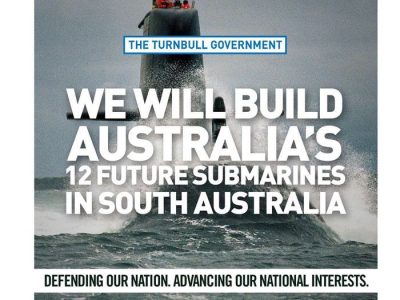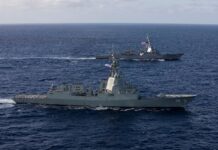 By Norman Friedman*
By Norman Friedman*
IN August a man turned over a computer disk containing 22,000 pages of technical submarine data to an Australian reporter working for a major Australian newspaper, The Australian. It was the latest twist in the lengthy saga of the Royal Australian Navy’s choice of a next-generation submarine.
The Australian Government had recently decided to let the contract for 12 new submarines to a French company, DCNS, which would build them in Australia. The disk was filled with a detailed description of a submarine DCNS had designed for India. The newspaper described the man as a whistle-blower, the implication being that by revealing all about an earlier DCNS design (and also about DCNS security) he was warning Australians that their government had made the wrong choice.
The Australian promptly posted samples (teasers) from the disk on its web-site, and for about a week speculation about its origins was rife. Later the Australian reporter wrote that the information had been collected by a DCNS sub-contractor, a former French naval officer, working in India on the submarine project. He had brought it to southeast Asia as background information to support a bid on a submarine contract, and it had come into the possession of another branch of his company in Singapore. Ultimately it was mailed to Australia in disk form. The whistle-blower was supposedly known to the Australian government, and planned to surrender the original disk. A few days after the original material was posted, The Australian posted further extracts which seemed to have been part of training manuals for the Indian submarines; that content was consistent with the claim that the data package had been assembled by someone involved in the training program set up for the Indians (the original data certainly was not). Much was made of the supposedly very secret character of the data, which seemed to include information on the submarine’s acoustic signature.
A few days after the original posting, DCNS went into court and secured an injunction against release of the full data package by the newspaper; it is no longer possible to say how much it contained. If the point of the exercise was to embarrass DCNS, it had already succeeded. It already seemed clear that the data had been assembled about 2011, and in France rather than in India; it reportedly included material on other DCNS projects of the time, including an unsuccessful bid to build frigates for Chile. DCNS pointed out that the Indian design had nothing in common with the one it had just sold to Australia. Those seeing the leak as unacceptable sloppiness on DCNS’ part countered that it could easily happen again, and that in the Australian case it might have wider implications. The Australian submarines are to have U.S. combat systems. Would the Americans withdraw if they felt that their security might be compromised?
This sort of argument would be more credible had the U.S. government not stated many times that cyber-attacks, mainly mounted by China, have already penetrated many U.S. defense contractors and have caused massive transfers of information. What the Australian leak really shows is how compact digital information is, and how unfortunately easy it is to steal. The 22,000 pages of the Australian leak would fill about 110 good-sized volumes. At one time a spy trying to get at all of that information would have had to copy it page by page, perhaps using a miniature camera which would hold enough film for ten or twenty shots. The entire Australian leak probably took up only a small fraction of the capacity of a disk. It is, moreover, difficult to see how DCNS could have protected itself from an ex-employee who took what he could while he had access.
The publicity accorded the DCNS leak is interesting in the context of the Australian submarine deal. At the outset, there were three competitors – the two established European submarine builders, France and Germany, and the new entrant, Japan. The previous Australian submarine contract, for the six Collins class, had been awarded to a Swedish company, Kockums. At that time the Germans were the dominant submarine exporters, and they were furious that they lost. The Collins class ran into serious teething problems because, despite being described as an off-the-shelf design, it was a drastically scaled-up version of Kockums’ existing submarine. The teething problems in turn fed into various Australian political disputes, making any future submarine purchase a very sensitive issue. That the Collins class is now quite satisfactory has become largely irrelevant in this context. Its problems seriously damaged the reputation of the Australian Submarine Corporation (which is to build the new submarines). They also put Kockums out of the running for the new competition.
Australia has some special submarine requirements, particularly very long endurance. Like the U.S. Navy, the Royal Australian Navy sees submarines as extremely valuable reconnaissance/surveillance assets. In its case the targets for surveillance are far from home. The mission might easily justify nuclear power, but that is politically unacceptable in Australia, despite the country’s position as a major world producer of uranium. When the current submarine program was announced, moreover, the new submarines were given a new mission. They would carry long-range cruise missiles, and thus would take over the strategic deterrent mission previously assigned to the now-retired Australian FB-111 bombers. Again, it might be argued that these weapons ought to have at least nuclear capability in an increasingly nuclear region, but again, any such speculation is politically impossible at present.
Initially Japan was a new factor in the Australian submarine question. The Japanese government has decided to reverse the ban on military exports. Japanese submarines have an excellent reputation, and unlike European ones they offer the sort of endurance the Australians want. Senior Australians visited Japan, and for a time it seemed that the Japanese would win the contract. The current Japanese submarine was prominently featured earlier this year at the first Japanese defense show.
There was some question as to whether the Japanese would be willing to transfer technology, or to have their submarines built in Australia (but there was also speculation in Australia as to whether the Australian Submarine Corporation should be allowed to build anything). Whatever the merits of the case, it appears that politics killed the sale. Opposition politicians found that any arms deal with Japan was an effective weapon against a government which made it. As elsewhere in Asia, memories of World War II remain vivid in Australia. In particular Australians retain a keen sense of the horrors inflicted on Australian prisoners of war, particularly the large number captured by the Japanese when Singapore fell in 1942. That included slave labor such as the construction of the ‘death railway’ in Thailand (the movie The Bridge Over the River Kwai recalls this episode). In a wider sense, unlike Germany, Japan has been unable to convince former enemies that she has come to terms with her wartime role and particularly her wartime crimes. It is still a major news story when Japanese officials visit the Yasakuni military shrine in Tokyo, which among other things proclaims that Japan’s war was justified as a crusade to free Asia from Western dominance (those freed in this way have sometimes pointed out that exchanging one overlord for an even more ruthless one was less than welcome). This problem has given China leverage among some Asian countries. Wartime history has made it extremely difficult to engineer a Far Eastern equivalent to NATO, even though that would make sense on a strategic level. An Australian deal to buy Japanese submarines might have been the beginning of a seismic change in favor of exactly such an arrangement.
With Japan out of the way, the two contestants were the unified shipbuilding industries of France and Germany. DCNS is the semi-private successor to the old official French naval shipbuilding organization. In Germany, Thyssen Krupp unites the two earlier submarine builders. In recent years DCNS has been very successful in the submarine market. In some cases countries have bought its submarines as replacements for ageing German submarines. Recent DCNS submarine customers are Brazil, Chile, India, Malaysia, Pakistan, and Spain. The company is currently competing for Norwegian and Polish orders. The choice of DCNS must have been particularly unpleasant for the Germans, who loudly proclaimed that the Collins problems would never have arisen had Australia made the right choice in the 1980s, namely them. The leaker in Australia was described (by The Australian) as a whistle-blower. The only injustice he could have been dramatizing was the award of the big submarine contract to the wrong party. The elaborate evaluation process which had led to the award to DCNS could not have been attacked on technical grounds. Security grounds were something else.
The Australian incident seems to have been a first in defense competition: an attempt to derail a choice on the ground that one competitor cannot protect its product. In the past, the commercial side of cyber-espionage was typically to find out (and beat) a competitor’s bid, typically on financial grounds. A company might also try to discover some innovation on its competitor’s part.
The security argument is, sadly, ludicrous. As the Snowden case shows, it is virtually impossible to protect even the most sophisticated organization against a determined insider. The Australian’s explanation of what happened to the DCNS data before it was leaked is not very credible; even it admits that there is no clue as to what happened to all that neatly digitized information between 2011, when it was created and stolen, and now. It seems likely that foreign governments have enjoyed access to the data. Probably the only defense against such theft is to keep changing the systems whose description can be stolen, so that the shelf life of stolen secrets is short. Obviously it is not possible to change a submarine’s diving depth or acoustic signature, but if much of what was stolen described the submarines’ combat system, that can be changed relatively rapidly. The U.S. Navy already does that in its ARCI (Acoustic Rapid COTS Insertion) program.
* Norman Friedman is author of The Naval Institute Guide to World Naval Weapon Systems. His column is published with kind permission of the US Naval Institute.


